30
March 2002
Lancing
beach proved
to be an exceptional discovery. The small patch of loose sponge-covered
flint rocks with small bits of chalk proved unusually rich in small rockpool
life at the very low tide (TQ
018 034). Katherine
Hamblett spotted
and Tacita French
caught
a Tompot Blenny, a small fish that is unusual
between the tides. I made hundreds of visits to the shore before I ever
caught one.

The
best buckets to use to temporarily house small fish and crabs for inspection
are light in colour. Fish will suffocate if left in a bucket for too long
on a hot day. The fish should be returned under rocks so they are safe
from marauding gulls.
Click
on the fish for identification
 Even
more amazingly Ray
Hamblett discovered a small Montagu's
Sea Snail, Liparis montagui, (a
small fish, a juvenile 40 mm* long) underneath
a rock. This is a small orange fish and although I had never ever discovered
one on thousands of visits to the shore. I immediately recognised it as
this fish is actually known to breed off Lancing. This was discovered by
the late John Barker and the species confirmed
by fish expert at the Natural History Museum Alwyne
Wheeler. Montagu's
Sea Snail has a string sucker-disc on its
underside that enables it to fasten itself to a rock with its tail turned
around its head. (* excludes caudal fin.) Even
more amazingly Ray
Hamblett discovered a small Montagu's
Sea Snail, Liparis montagui, (a
small fish, a juvenile 40 mm* long) underneath
a rock. This is a small orange fish and although I had never ever discovered
one on thousands of visits to the shore. I immediately recognised it as
this fish is actually known to breed off Lancing. This was discovered by
the late John Barker and the species confirmed
by fish expert at the Natural History Museum Alwyne
Wheeler. Montagu's
Sea Snail has a string sucker-disc on its
underside that enables it to fasten itself to a rock with its tail turned
around its head. (* excludes caudal fin.)
Original
Report (Sussex Rare Fish)

The
children discovered over a dozen rockpool fish
of four species to much excitement, as well lots of different crabs.
Furthermore,
the beach was home to five species of sea anemones
including large Dahlia
Anemones and frequent Snakelocks
Anemones, enough to identify this location as the most easterly
regular location of this sea anemone on the northern English Channel.
The Pimplet
Anemone was also discovered, another anemone species that has never
been recorded this far east before.
Full
Report
BMLSS
Sea Anemones
Adur
Estuary Survey by the late John Barker
Sanderlings
(x
20 +) (a small wading bird) fed energetically
alongside the sandy pools and a the margins of sand and sea.
A
flock of about 100 small to medium-sized black birds flew in a formation
eastwards, but too far out to sea to be sure of their identity. They were
probably Common
Scoters. The fluctuating shape of their
flock formation was particularly noticeable, strung out in long lines as
they flew rapidly.
A very
clear sunny morning with just a fresh chill in the area, but no wind and
the mud flats adjacent to the airfield were resting places for gulls and
Cormorants.
Instead
of the usual black heads, one of the four Cormorants was particularly striking
(full breeding livery) with a heron-like grey face and neck. Gulls included
a Great Black-backed Gull
and a Lesser Black-backed Gull,
but
were mostly Herring Gulls.
An
exceptionally high 6.9 metre equinoctial spring tide occurred just after
midnight at 12:06 am at Shoreham-by-Sea. Although this high tide was forecast
there were no additional prevailing weather conditions that would cause
floods and the water rose no higher than a normal spring tide.
BMLSS
Tides Page
29
March 2002
A
Peacock
and Holly Blue Butterfly
seen in my Lancing Garden (TQ 185046).
The
tide went out an exceptionally long way on Lancing
beach (TQ 018 034) where
there were Hermit Crabs, Shore
Crabs, prawns and other critters in the
shallow pools that were exposed. A Dahlia
Sea Anemone was recognised from the
photographs.
BMLSS
Rockpooling
28
March 2002
The
first Full Moon since the Vernal
Equinox shone clear and large in the late afternoon sky. A pregnant
5-Bearded
Rockling was amongst several species of rockpool
fish in the shallow pools under Worthing Pier.
Full
Report
27
March 2002
With
sunny days and chill nights, a large yellow-white butterfly
is seen in Fishersgate, presumably a Brimstone,
unless the white butterflies are very early.
A
probable Small Tortoiseshell Butterfly
in
flight over a bostal near Shermanbury.
25
March 2002
It
feels a bit like spring, with the sun shining, no wind, but the ground
is still squelchy underfoot and the soil temperature may even fall below
freezing at night.
Peacock
and Brimstone Butterflies in
flight at Shermanbury
and Small Tortoiseshells
at Botolphs.
Adur
Butterflies
24
March 2002
A
flock of 25 Jackdaws
rose from the Beech tree in The Drive (near Buckingham Park), Shoreham-by-Sea.
I also spotted my first butterfly of the
year, a Peacock,
bathing in the sunshine amongst the garden plants (TQ
219 063).

23
March 2002
Peacock
Butterflies and Great
Spotted Woodpecker at Shermanbury
and a Hedgehog
has awakened from hibernation in a Lancing garden (TQ
185 046). A Song
Thrush pays a regular visit to the bird
table.
21
March 2002
In
the green open space between Brooklands Boating
Lake and the railway line, a female Sparrowhawk
was
seen struggling with a large item of prey or carrion from the ground to
the height of several feet when it appeared to be mobbed by a Starling.
The view was from the train window and was too fleeting to identify the
prey which looked pinkish in colour and probably weighed about 300 grams
(pigeon-sized), possibly more, up to 500 grams
20
March 2002
Vernal
Equinox at 19:03 GMT (UT).
18
March 2002
After
three days of almost continual rain, 1.3 cm of rain fell in the morning.
At nearby Findon there were mudslides and floods.
16
March 2002
One
of the Robins
is constructing a nest behind the garden shed in my south Lancing garden
(TQ
185 046). We have seen it fetching dried leaves
from a neighbours garden and returning to a shady area, close to ground
level at the fence side of the shed. Robins are often ground nesting birds
but this is on a direct route used by cats, so it is very unlikely the
birds will breed successfully.
A
Wren
was seen with a big green caterpillar in it's beak, when it had bashed
it on a log a few times, it carried the grub up to the Hawthorn Tree and
disappeared from view.
15
March 2002
The
Lapwings
now all seem to have dispersed to search out their breeding territories,
as there were none on the Adur at low tide. Three wheeling flocks of Dunlins
each numbered over 30 birds and there were dozens of these small plump
birds feeding on the mud and waterline, and the handful of Redshanks
were too busy feeding to sound their alarm call.
 A
solitary Rock
Pipit was seen amongst the Sea Purslane.
The bird was identified as a brown bird with greyish-bordered tail feathers
visible as it flew away. This was the first one I have identified locally,
although they may have been spotted as Meadow
Pipits before. This bird may be a Scandinavian
Rock Pipit (a sub-species). A
solitary Rock
Pipit was seen amongst the Sea Purslane.
The bird was identified as a brown bird with greyish-bordered tail feathers
visible as it flew away. This was the first one I have identified locally,
although they may have been spotted as Meadow
Pipits before. This bird may be a Scandinavian
Rock Pipit (a sub-species).
Kent
Ornithological Society Rock Pipits Discussion
A couple
of Wheatears
have arrived by Widewater for the first report
of these migrants this year. 150 Brent
Geese were also seen flying east a long
way out to sea, and a flock of 15 Turnstones
inshore.
c.
13 March 2002
Frog
tadpoles appeared in a Shoreham garden
pond (TQ 219 063) around
this date. The larger tadpoles, pea-sized probably came from the spawn
laid c. 7 February 2002
but many of the tadpoles were just thin slivers and they are probably from
the batch laid a couple of weeks after the first permeable clump.
Freshwater
Life of North-western Europe Smart Group
11
March 2002
Eight
Turnstones
fed on the waterline on the low tide mussel beds
underneath the Railway Viaduct on the River Adur. They were well camouflaged
but their red legs could be discerned. This time when one of them preened
its belly it was clearly white. Two further Turnstones
flew over the viaduct and back again and then all eight of these wading
birds flew off a short distance in formation, showing off their piebald
patterns, and making their distinctive call.
Lapwings
were absent, but the Little Egret was stalking the shallows on the
opposite west side of the river by Adur Recreation Ground for a change.
 8
March 2002 8
March 2002
A
restless and very "loud" almost greeny yellow butterfly
was seen near Shermanbury
as we enjoyed the first fine sunny weather of the year. It was probably
a Brimstone
Butterfly.
South
Downs Butterflies
Butterflies
of Adur
On
Widewater
Lagoon, a pair of Red-breasted Mergansers
shook
themselves and dived under the water. The Little
Egret was still there fishing in the shallows.
A
chirm of 20 Goldfinches
adorned
the shrub on the south side of the lagoon.
5 March
2002
The
spawn of the nudibranch (sea slug) Onchidoris
bilamellata was recorded under Worthing
pier.
Redshanks
(x 8+) were noticeable amongst the energetic Dunlins
(x 50+) and Grey Plovers
with all of the common species of gulls on the mud north of the railway
viaduct on the Adur estuary.
4 March
2002
The
0.6 metre low tide revealed a single specimen of the sea anemone Sagartiogeton
undatus, but as the area below the Tide Level Marker was still
under water, there could be other sea anemones,
as this is the best known location for this sea anemone that I know. A
single specimen of the nudibranch (sea slug) Onchidoris
bilamellata was also discovered under a barnacle encrusted
rock. This species is common in spring when it comes into breed on the
exposed shores at Ovingdean and Worthing
but on this sheltered shore it is rare. Some Oysters
were large enough for eating and one Whelk was
buried at cockle-depth in the sand.
On
the mud flats the most noticeable birds were three Oystercatchers
which have not been so often this winter. Some other birds were making
a tremendous amount of noise, including one unseen Redshank
that
sent all the birds bar the gulls into flight. Their warning call was supplemented
by a chippy call, more persistent and harsher, but it could be mistaken
for the call of a Turnstone.
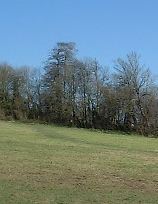 2
March 2002 2
March 2002
McIntyres
Field (north of Lancing Manor) has been
forage harvested during the winter by a contractor appointed by the South
Downs Conservation Board. There was a delay for this job to be completed
due to problems with sourcing a contractor with the necessary equipment
and at a price within the board's budget for maintenance work.
If
this work was not done, the field would soon revert to scrub with Dogwood,
Brambles and tree seedlings crowding out the grass meadow plants.
Lancing
Nature News (March 2002)

28
February 2002
There
may be at least two Little Egrets
regularly on the River Adur this year as one was
seen in a field to the rear of the cottage near Cuckoo's Corner (first
carpark from the south on the Coombes road)
and another wading in the shallow pools surrounded by mussel
beds underneath the Railway Viaduct.
Of course, the bird may have flown from Cuckoo's Corner quicker than I
could cycle.
26
February 2002
Greenfinches
are currently the second most predominant bird in my south Lancing garden
(TQ
185 046) with the House
Sparrow at number one.
Sparrows
normally number 6 to 10 birds but often exceed that. There have been up
to 12 Greenfinches about 3:1 females to males. A typical count would be
around 6 birds.
The
Wren
is visiting regularly, flitting and hopping rather mouse-like through the
shrubbery, picking out small grubs.
The
Robin
appears daily mostly feeding from the ground on small insects.
A
female Chaffinch
was seen once at the weekend on the ground in the garden.
A
pair of Collared Doves
are settling in to the Hawthorn tree.
A pair appear every spring and begin nest building, I have not yet seen
a successful brood produced.
22
February 2002
 Coots
(x30) and Moorhens
(x15) shared Brooklands Boating Lake with Mallards
and Mute Swans,
which is usual in most months of the year, but the Pochards
(x15) were less usual and they can be seen up much closer than at Widewater
Lagoon a mile to the east. On the green, the squint eye and yellow legs
identified the Common Gull up
close. Coots
(x30) and Moorhens
(x15) shared Brooklands Boating Lake with Mallards
and Mute Swans,
which is usual in most months of the year, but the Pochards
(x15) were less usual and they can be seen up much closer than at Widewater
Lagoon a mile to the east. On the green, the squint eye and yellow legs
identified the Common Gull up
close.
Wading
the Widewater submerged margins, the brilliant
orange of the large Ruddy
Shelduck was the last bird to be seen
after the Little Egret
in the shallow lagoon to the east of the bridge and the Red-breasted
Merganser on the surface over the deeper
water.
Over
Lancing Beach Green where the Sailing Club building was being rebuilt,
a solitary bird flew just like the Turnstones
of a week ago. Only this time the fleeting rear view was different with
far more white, and the call was "kee-oo kee-oo"
which makes this bird to almost certainly be a Redshank,
although the call was not the shrill alarm of this wader when it is suddenly
disturbed on the estuary.
About
a hundred small birds were observed flying west over the sea, just above
the waves in flocks of 30 and 60+, only a 100 metres from the cycle path,
just 50 metres, from where the sea lapped on the shore, but the birds were
too small and quick for me to identify. I would go for Dunlins
as the most probable birds.
The
chirm of Goldfinches
in
the shrubbery between the lagoon and the sea numbered about 30 but they
were outnumbered by about 100 noisy House
Sparrows in the neighbouring bushes.
Friends
of Widewater Lagoon
18
February 2002
Adur
World Oceans Day 2002
The
first meeting to discuss arrangements for this Adur Festival event.
Please
express any interest to:
Andy
Horton (British Marine Life Study Society)
Tel:
01273 465433
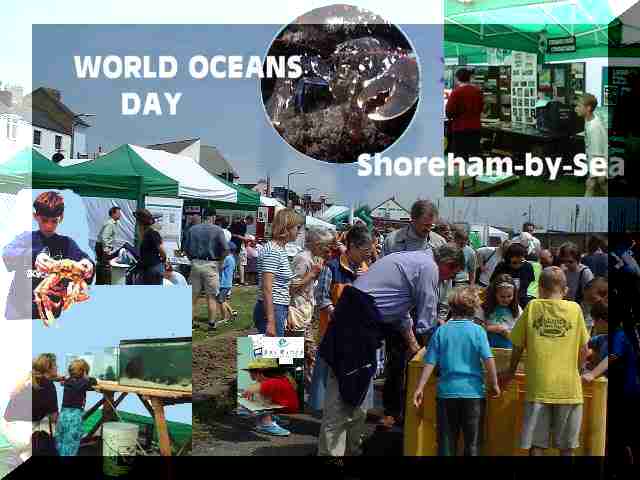 Glaucus@hotmail.com Glaucus@hotmail.com
or
Neil
Mitchell (West Sussex County
Council)
Tel:
01243 756856
Adur
World Oceans Day 2001 web page
World
Oceans Day
17
February 2002
Jackdaws
(x 3), Chaffinches
(x 2) and a Wren
amongst the shrubs are three less common visitors, (but not particularly
special), to a north Shoreham garden (TQ
219 063) where further frog spawn was
deposited in the small pond during the week. This as the last spawn deposited
this year.
16
February 2002
A
Small
Tortoiseshell Butterfly is active in my
south facing front garden in Lancing. Greenfinches are visiting
regularly.
Butterflies
of Lancing
15
February 2002
A
small formation of four wading birds flew rapidly over the shingle shore
and imported Larvikite (a type of syenite)
sea defence rocks (TQ 213 044)
opposite Beach Green, (by the beach huts) in mid-afternoon. These birds
could be clearly seen with a white wing bar when flying away (not like
the white rear edge of the Redshank)
and there call was a clear "tik-tik-tik"
of
Turnstones.
A flock of three Turnstones
have also been reported from Southwick Beach.
Shoreham
Beach
13
February 2002
Lancing
Ring
A
party of about 20 volunteers with the South Downs Conservation Board, led
by Countryside Ranger Richard James,
gathered for a scrub clearing session on the South-west slope of Lancing
Ring. The task was to remove some of the Hawthorn
which is seen to be invading the chalk grassland which itself has been
colonised by Tor
Grass, Brachypodium pinnatum. The SDCB hope to introduce
grazing by Exmoor Ponies which have proved successful on downland at Firle
near Lewes, East Sussex.
Tor
Grass Information Files:
 Firle
near Lewes Firle
near Lewes
Sussex
University Bulletin
Action
Plan Link
Lancing
Nature Newsletter (February 2002)
Adur
Estuary
I
thought I would take a short detour to the Adur near Old Shoreham Toll
Bridge to try and clear up the identity of the waders seen yesterday. Alas
amongst the 1000+ Lapwings and
assorted gulls, the various waders seem to pose more problems than they
solved. A flock of 75 or so Dunlins were
easy to separate by size, but again the medium-sized waders still posed
problems. A handful of stocky ones with black beaks and dark legs were
Grey
Plovers.
At
least a couple of wading birds with pale yellowish
legs and much darker (less thrush-like) breast,
embarked on a very steady and fast trot along the edge of the waterline.
These actually turned out to be Redshanks.
"The
identification of these waders is simply fraught with too many difficulties
to be sure. The Redshank, usually long and spindly, can actually look quite
squat at a long distance and at an angle the medium-long beak can actually
look shorter. In the poor light, even the leg and beak colours can be difficult
to discern."
Through
the binoculars the unringed Little Egret
stilting
on its long black legs, looked really large in comparison to every bird
bar the Great Black-backed Gulls.
Sussex
Ornithological Society Waders Files
Royal
Society for the Protection of Birds (RSPB)
12
February 2002
After
the gales the strandline of Shoreham
Beach was peppered with thousands of Whelk egg-cases,
amongst the flotsam of shells, seaweed and man-made rubbish.
A
flock of 25 Turnstones
wheeled in by the Adur Railway Viaduct just like a flock of Dunlins. These
birds were much stockier than the solitary Redshank,
which was elegantly feeding within a few metres of one of these waders.
-
"A wader slightly smaller than a Lapwing, squatter and fatter than a Redshank,
speckled a bit like a Thrush, bright red legs like an adult Redshank, shortish
dark beak, jerky feeding, quite inclined to submerge its legs, in a small
flock of 25 wheeling like a Dunlin flock, much larger than a Ringed Plover,
but smaller than an Oystercatcher. When the bird ruffled its feathers a
small area of white was revealed on its flank and belly." -
These
waders in their dull winter plumage were about the same size as a couple
of Grey Plovers
foraging along the water line at mid-tide. Some of them waded in the pools
near the mussel beds with their legs submerged,
but they were not adverse to feeding on the mud flats.
A
few Wrens
arrowed between the scrub bushes by the disused railway route to the south-east
of Old Shoreham Toll Bridge.
Adur
Estuary Page
10
February 2002
The
wader feeding jerkily over the edge of mud and water near the railway viaduct
with bright red legs (and
smaller than a Lapwing) must surely be
a Redshank,
(but originally misidentified as a Turnstone).
It was originally disturbed by the helicopter from a mud and rocks area,
when it called twice as it flew about 30 metres to the water's edge. The
other wader was probably a Grey Plover.
On this murky day colours were a bit subdued.
7 February
2002
On
a wet and blustery day a small flock of 30 Dunlin
wheeled over Widewater .The resident albino Mallards
tucked their heads into their breasts.
c.
7 February 2002
A
Common
Frog laid a small clump of spawn in a Shoreham garden (TQ
219 063) between the dates of 4 and 10 February.
This
spawn was earlier than usual. At the beginning of this Millennium, spawn
was not recorded in Shoreham until 27 February 2000.
Freshwater
Life of North-western Europe Smart Group
6 February
2002
"Kwaa!
kwaa!" yelled the gull with the big yellow
beak, whilst simultaneously pattering its feet to encourage the worms to
rise. Not on the beach but on the Hamm
outside Adur Civic Centre. The is was almost certainly a Herring
Gull, a common sight in Shoreham
town. The idea to check is to look at the colour of its legs, which are
red in this species, but this gull was crouching down and being aggressive
so I could not see their colour. All the playing fields and parks were
covered in mostly Black-headed Gulls
after the gales (which also have red legs, but they are much smaller).
4 February
2002
 Gale
Force 8 winds and steady rain throughout the whole of the day that
died down by the evening. Gale
Force 8 winds and steady rain throughout the whole of the day that
died down by the evening.
3 February
2002
Professor
Richard Ivell visited
Widewater
Lagoon, Lancing, West Sussex, to show a group of naturalists and local
residents where he discovered the very rare sea anemone Edwardsii
ivelli. He also explained how they were discovered which should
enable us to try and and discover them again this summer when the water
recedes. After the recent rain the the lagoon
was in flood, covering the Glasswort,
Salicornia
sp, completely. The miniature sea anemones were
originally discovered on a study of the Lagoon
Cockle, Cerastoderma glaucum,
which buries deeply (to 10 cm) in the soft sediment. They revealed themselves
in the bucket of mud and cockles.
(NB:
The 1997 survey took core samples.)
Friends
of Widewater Lagoon

A flock
of about 35 Pochards
cheered us up in the rain. These ducks appear like a dark blob at first,
their grey backs camouflaged quite well against the rippled water, repeatedly
diving under the surface. In the shallows a Little
Egret was repeatedly feeding right on
the edge, probably not on the abundant Three
Spined Sticklebacks, Gasterosteus aculeatus, although I
am not quite sure what the Egret was stabbing at.
JNCC
Proposal to remove Edwardsia ivelli from Schedule 5 protection (Link)
Saline
Lagoons Action Plan
1 February
2002

Waves
and high spring tides pound the beach by Widewater
Photograph
by Ray Hamblett
Although
the tides were forecasted at 6.8 metres, as high as any in the last 25
years, the sea did not rise exceptionally or even particularly high at
the Surry Yard on the River Adur estuary.
Beaufort
Scale (sea)
Beaufort
Scale (land)

 29
January 2002 29
January 2002
A
group of five Long-tailed Tits
arrive in a Shermanbury
garden and feed on bread underneath the feeder. This bird feeds on insects
so it is a rare visitor to bird tables. This lightweight bird is not a
true titmouse of the genus Parus but classified in the family Aegithalidae.
Report
from Cuckoo's Corner 2000
28
January 2002
The
Redshanks
sound the alarm call and 1000+ Lapwings
and 500+ gulls took
to the air near Old Shoreham Toll Bridge.
26-27
January 2002
RSPB
Annual Garden Bird Count
Survey
Form (link)
Top
Five Garden Birds in West Sussex 2001:
1.
House
Sparrow
2.
Starling
3.
Blue
Tit
4.
Blackbird
5.
Great
Tit
Garden
Birds of Adur
24
January 2002
A
Public Meeting at Lancing Parish Hall to discuss with the Environment Agency
the effect shingle movement is having on water levels in Widewater
Lagoon. There are presentations by Rupert Chubb (Flood defence Manager,
Environment Agency), Derek Neate (Friends of Widewater Lagoon) and Councillor
Tony Nicklen.
Glasswort
Page
 22
January 2002 22
January 2002
Gliding
less than a metre above the road surface, south of Cuckoo's Corner (TQ
201 064), a male Sparrowhawk
flew at least 20 metres along the road before veering suddenly in the hedgerow
on the right. It was identified as a male by its slate-bluish colour, and
as a Sparrowhawk by its behaviour including the fanning of its tail as
it swerved adeptly between the bare hedgerow branches in a way that would
not be common for the Kestrel. A Kestrel,
a regular sight on waste land, had spent some time gliding and hovering
near Old Shoreham on the east side of the Adur,
so I was able to contrast the two falcons.
Huddleston
& Jackson Ringing Partnership Web Site
18
January 2002
A
Great
Tit was many of bird visitors in my Lancing
garden.
 14
January 2002 14
January 2002
On
the estuarine Adur mudflats, thousands (about
2500) of Lapwings
exceeded any numbers I had noted before and they were on all the exposed
mud on both sides of the river, with the greatest numbers near the Toll
Bridge. When disturbed by the helicopter their "peewit" calls were
most noticeable. At least two, Grey
Plovers searched for invertebrates on
the mud.

12
January 2002
A
Jay
could be clearly seen in the denuded broadleaf branches in Church Lane,
Southwick, near the vicarage of St. Michael's Church; a common enough sight
in this side road, but will it remain so if ever the wood in this road
is developed?
11
January 2002
The
low spring tide at Kingston Beach only receded
to 1.2 metres above Chart Datum so the lowest
most interesting part of this beach was still under water. However, despite
this and January is usually the least interesting
of all the months of the year, there were still small Blennies
under rocks, a tiny 6 mm Butterfish and a few
prawns,
Palaemon
elegans, in the pools underneath the groynes.
 The
most notable discovery were large Dogwhelks
averaging 50 mm in length (all a dirty white colour) and one group were
laying their egg capsules. Unusually, small Common
Starfish were present under rocks
and at least one Common
Whelk was discovered amongst the oysters. The
most notable discovery were large Dogwhelks
averaging 50 mm in length (all a dirty white colour) and one group were
laying their egg capsules. Unusually, small Common
Starfish were present under rocks
and at least one Common
Whelk was discovered amongst the oysters.
Full
Report
Dogwhelk
page
Trouble
with Dogwhelks
A Fox
brazenly
trotted from one twitten to another across Gordon Road, Shoreham, right
in the middle of a residential area and very near where I was brought up
in Rosslyn Road. This is an area of terraced houses and narrow smallish
gardens, although there is some waste land next to the railway line. The
Fox looked healthy and very grey, although at 10:00 pm and it was only
lit up by the street lamps and colours were not bright. Foxes have been
seen frequently in town.
 10
January 2002 10
January 2002
The
River Adur estuary between the Norfolk bridge
and the A27 Flyover sported a particular large number of sea
birds as the low spring tide receded exposing the mud flats north of
the Railway Viaduct and the mussel beds and gravel to the south. Nothing
special although the large stumpy wader known as the Grey
Plover (x2) made sudden darts to capture
its food. In order of prevalence the bird selection with over a hundred
birds included Lapwings, Black-headed Gulls,
Dunlins and Great
Black-backed Gulls. There were significant
numbers of Redshanks, Oystercatchers,
Herring
Gulls, Common Gulls, and a few Mute
Swans. A large Little
Egret fished in a pool by the viaduct,
and a Ringed Plover
could be picked out from the gravel. On the vegetated mudflats by the houseboats,
seven Grey Herons
stood statuesquely. Crows
foraged around the smaller boats by the Norfolk bridge and on the towpath
adjacent to the airport. The absence of Cormorants
was not an omission. There were none to be seen.
Sussex
Ornithological Society Gulls & Terns Files
7 January
2002
A
small chirm of four or more adult Goldfinches
made
an attractive addition on the fence of the playing fields to the west of
the Church Green estate, Middle Road, Shoreham.
6 January
2002
52 Pochards
were recorded by Colin Upton (Brighton RSPB) leading a group of birdwatchers
at Widewater Lagoon. These ducks were also reported
before Christmas at Widewater.
 4
January 2002 4
January 2002
With
the broadleafed shrubbery and woods bereft of greenery, the Robin
Redbreast can be seen at this time of
year, a flash of red amongst the Sycamore on the Waterworks Road. The Robin
in the photograph was taken by Allen
Pollard at Shermanbury.
A solitary diving bird on
the River Adur, just north of the railway viaduct,
on a flood spring tide on a murky afternoon was not familiar to me.

This black bird with a white
breast turned out to be my first choice of a Razorbill.
The mystery is why this bird was on its own and not out at sea with the
large flocks. The bird, which did not fly away but took to the water when
disturbed, was probably injured.
Adur
Estuary pages
 2
January 2002 2
January 2002
ABullfinch
made a visit to a Shermanbury
garden. This very distinctive bird is unlikely to be missed, but I have
never seen one around Shoreham. Over a thousand have been ringed over the
years at the Shoreham sanctuary near the Waterworks on the Adur
levels.
Allen
Pollard's Then & Now web pages
Adur
Levels
1 January
2002
On
Steep
Down Hill (TQ 168 075),
north of Lancing, patches of snow lingered on the ground among the corn
stubble on a sunny but chilly day. Near the summit the sound of Skylark
was unmistakable, at least two birds could be spotted soaring overhead.
Full
Report on the Adur Valley Eforum
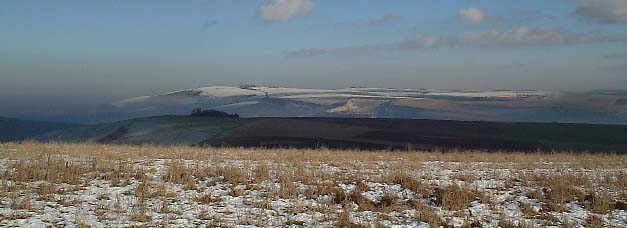
From
Steepdown to Truleigh Hill with a light layer of snow
Photograph
by
Ray Hamblett
Images
on Smart Groups |


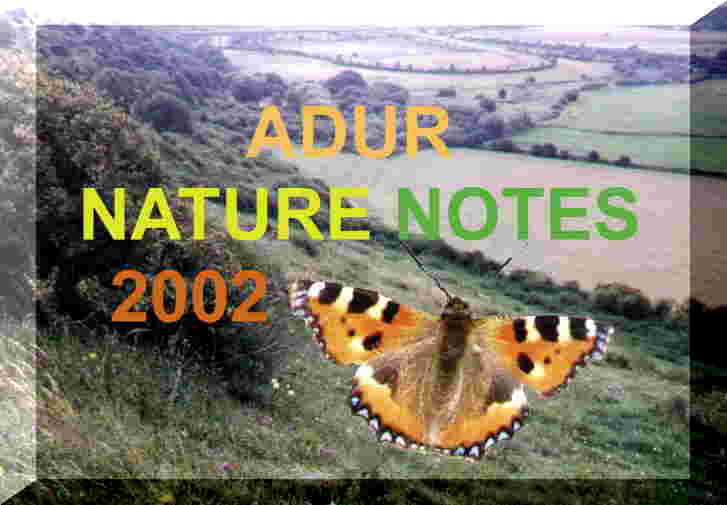

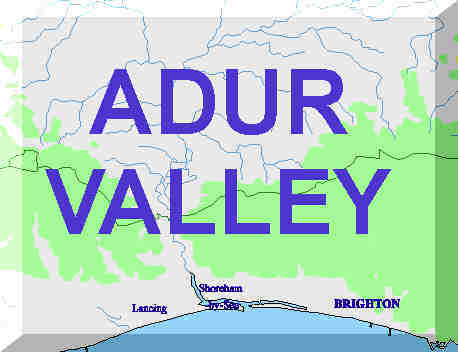

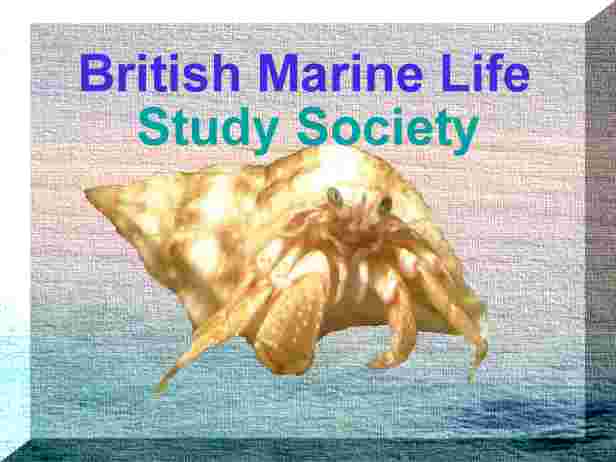

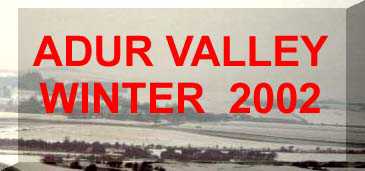












 Gale
Force 8 winds and steady rain throughout the whole of the day that
died down by the evening.
Gale
Force 8 winds and steady rain throughout the whole of the day that
died down by the evening.







 2
January 2002
2
January 2002
